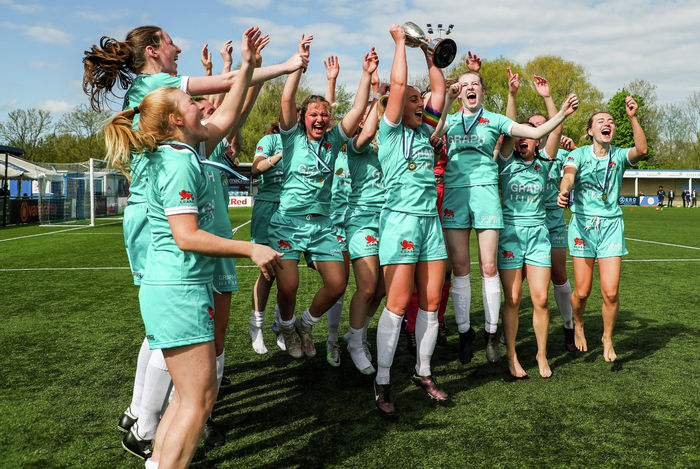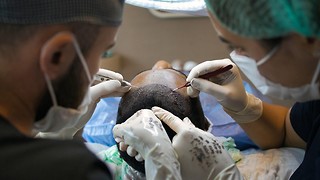‘We had no contact with the men’: the women’s Blues in the 90s
Varsity investigates how women’s football in Cambridge has changed over the last 30 years

“It wasn’t really very girly, girly out there” was a Cambridge player’s description of a match in which two players were carried off. She was right.
Women can kick each other! Shock in the pages of Varsity, as people playing a contact sport sometimes come into contact with others. That such a usual occurrence as football players getting injured was noteworthy enough to start the most important match report of the year says rather little about the match itself but lots about the journalistic quality (read: sexism) of the Sports section circa 1990.
The match report from that year’s Varsity match against Oxford was matched in feminist ballast by a later report from a game against Ipswich. Outlining the positives of the performance of the women’s Blues against Oxford, our enlightened writer reminds us: “no dissent, no cynical challenges and plenty of skillful forward play – such are the pleasures of ladies’ football, at university level at least.” The small group of fans who watch the current Blues would likely disagree. Nevertheless, we should give our man some credit, as he boldly argues:“they played the kind of neat close-passing game which, if adopted in loftier circles, might bring the crowds flooding back to our national game”. Readers with longer memories or history books might quarrel with the idea that a propensity for long balls was the only impediment to the safe and enjoyable experience of a football game in the early 90s, but it’s clear that the women’s Blues were the originators of tiki-taka.
Such high technical quality was undoubtedly the result of the Blues’ exposure to high quality football. Anna, the team’s former left back and secretary was a committed Arsenal fan. She modelled herself on, err, Lee Dixon. In her defence, she had no female role models to copy. “There was just not an option. It just wasn’t a thing, like completely zero experience or knowledge of any woman’s football”. Likewise, Jane (a thwarted midfielder who captained the Blues from centre back) had only ever played in the garden with her brothers and before and after athletics training with her friends. Once they got to Cambridge, however, it was a different story entirely.
It’s clear that the women’s Blues were the originators of tiki-taka
“I think I was either playing or training six days a week”, Anna recounts: “because you’d be playing for college one day, you might have college practice one day, you’d be playing Blues one day, and then you’d have fitness one day and then have training one day”. Understandably she says: “it felt like we had a very intense kind of training”, and one I can personally vouch for is not shared by the current Blues team. Jane, as captain, was in charge of these sessions. A cross country runner for Cambridge as well as a footballer (and thus the holder of two half-Blues, which disappointingly do not make a full Blue), she emphasised fitness in her training sessions. Her teammates “will inevitably say to you: ‘God, Jane was obsessed with running and she’s obsessed with fitness’”, after her training sessions left them with “PTSD from the trees on Jesus Green because we would like to sprint in between them”. Such hard graft paid off though, and the match report from the Varsity match in her year as captain highlighted: “in the final minutes the Light Blues’ superior fitness began to pay dividends”. It also described Oxford as “more relieved than their Cambridge counterparts at the sound of the final whistle”.

If their performance in the Varsity match was outstanding, the surroundings were perhaps less so. In the late 80s and early 90s, the women’s Blues were completely independent from the men’s club CUAFC, instead playing for CUWAFC. “We had no contact with the men”, nor did they “see any money that they got”, Anna recounts. The women’s Varsity match was not held in the propitious surroundings of Craven Cottage, which was itself (according to an English student by the name of Andrew Burnham) an example of a sharp fall in “the grandeur of the chosen ground”, but rather at St John’s Sportsground. The team were not put off by the lack of stands and toilet facilities and “got Cambridge University Brass Band to play, so we were trying to make it like an event”. That this event had more in common with a village fete than the FA Cup final was neither here nor there for the players, who enjoyed the game with their “small but keen group of travelling fans”.
Remarkably, it seems as if most colleges had at least one team entered into the League or Cuppers. This will be a shocking revelation for anyone who follows women’s college football now
Blues fixtures were not the only football on offer to keen players, as a thriving college league and Cuppers tournament opened up the sport to those not good enough to don the hallowed light blue shirt. Both Anna and Jane were at Girton and, at that time, the college had two football teams on its own. Remarkably, it seems as if most colleges had at least one team entered into the League or Cuppers. This will be a shocking revelation for anyone who follows women’s college football now, as teams are regularly shared across two colleges and sometimes in the case of small or postgrad colleges, three. Anna says: “there were at least two divisions”, and that although “the difference between the top teams and the lower teams was in the league was quite a lot ... there wasn’t such a big gap” in standard between the Blues team and the college teams. Jane puts the strength of the league down to a “big sort of sporting culture. When you’re at uni, a lot of sport being played!” Reflecting on the football scene after I tell her that my college side regularly fields eight or nine players, she posits: “Amazingly, in some ways, maybe there were more people playing” during her time at Cambridge than now. She’s almost certainly right. 29 teams entered into Cuppers in 1990, which dwarfs the 16 who played in the first round of this year’s competition.
One excited Varsity reporter thought that the strength of the Cuppers competition meant that football had turned a corner against the patriarchy. “Virtually every college now has a ladies’ team, dispelling the image of football as an exclusively male sport”, he wrote. Sexism continues to blight the national game, but Anna, Jane and their teammates spearheaded a revolution of sorts. A very quiet one, a very Cambridge one, but a revolution nonetheless. After all, they didn’t half kick each other.
 Features / Meet the Cambridge students whose names live up to their degree9 September 2025
Features / Meet the Cambridge students whose names live up to their degree9 September 2025 News / Student group condemns Biomedical Campus for ‘endorsing pseudoscience’10 September 2025
News / Student group condemns Biomedical Campus for ‘endorsing pseudoscience’10 September 2025 News / Tompkins Table 2025: Trinity widens gap on Christ’s19 August 2025
News / Tompkins Table 2025: Trinity widens gap on Christ’s19 August 2025 News / New left-wing student society claims Corbyn support11 September 2025
News / New left-wing student society claims Corbyn support11 September 2025 Science / Who gets to stay cool in Cambridge?7 September 2025
Science / Who gets to stay cool in Cambridge?7 September 2025









